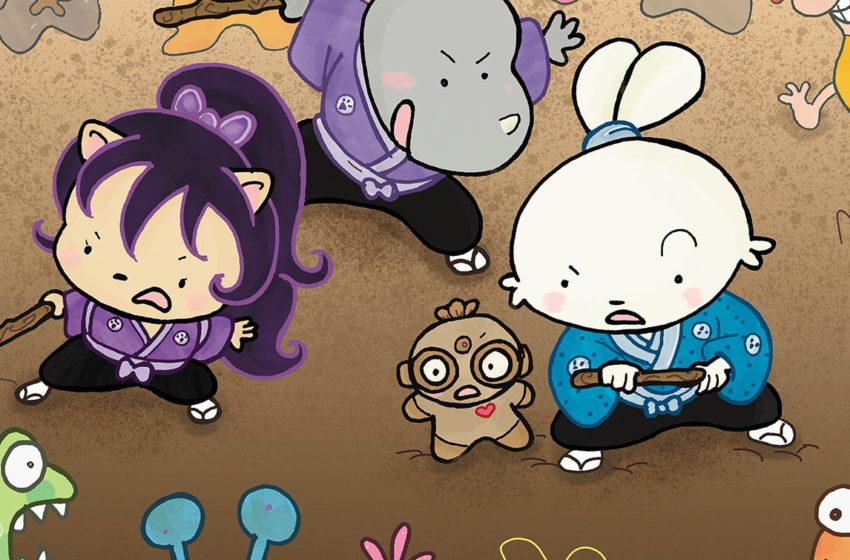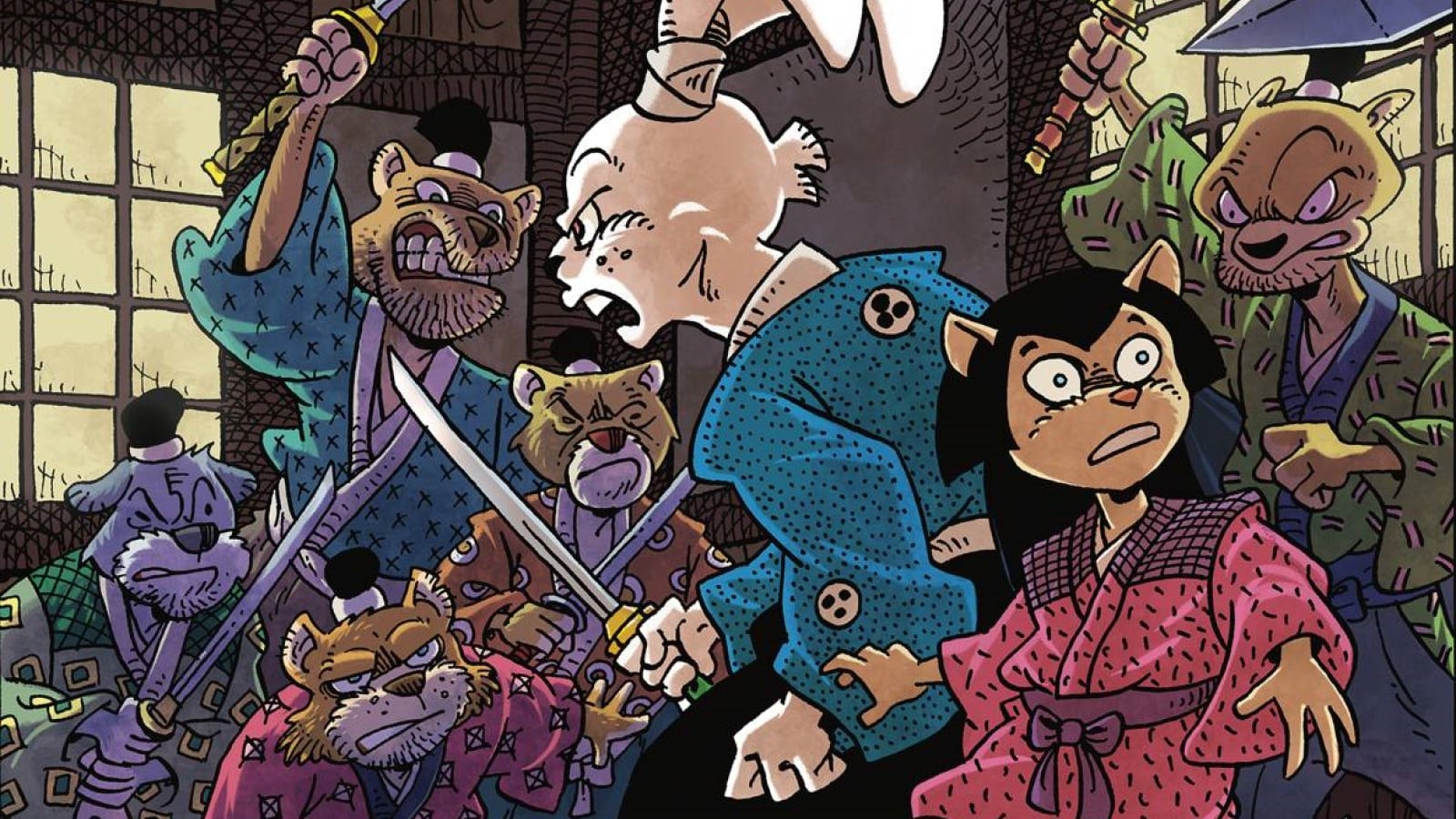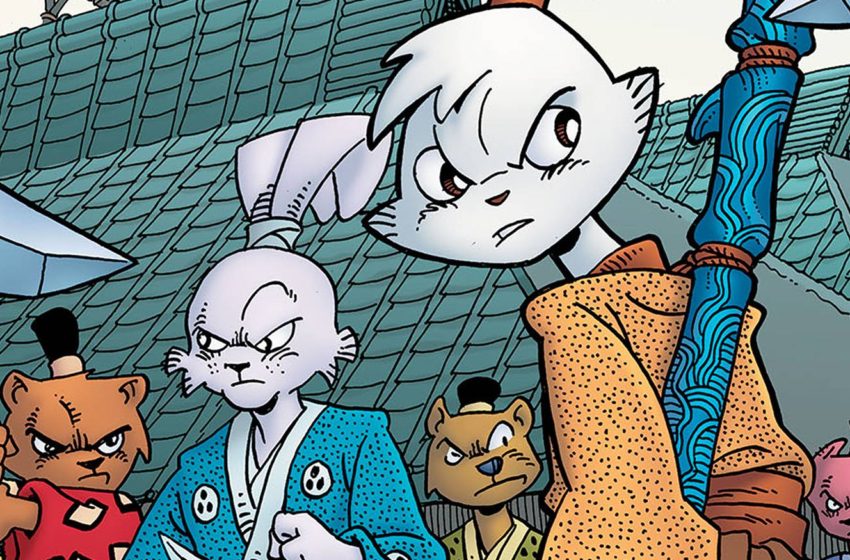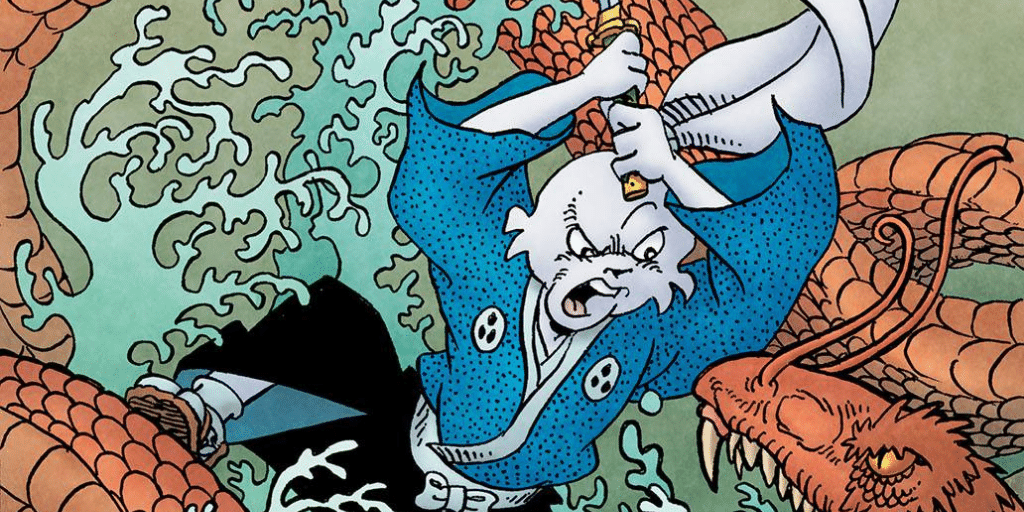Stan Sakai’s beloved rabbit samurai has won countless fans over his 35-year history, thanks to a clever blend of thrilling action, heartwarming characters and realistic portrayal of Japanese culture. Chibi Usagi brings these fun and thoughtful stories to middle grade readers as an original graphic novel packed with adorable art and captivating energy by Julie Sakai (story, art, lettering), Stan Sakai (story and art) and Emi Fujii (colors).
The Origins of Chibi Usagi
In 2016, Stan Sakai began a series of mystery stories in the pages of Usagi Yojimbo involving the popular recurring character Inspector Ishida. This series of stories, culminating in the emotional tour-de-force The Hidden, capped off Sakai’s residency at Dark Horse comics, and while I would never describe any Usagi Yojimbo story as “dark” or “gritty,” Inspector Ishida stories generally deal with murder and conspiracy. These stories come as close as this comic ever does to a film noir sensibility. If the general mood of noir is a kind of bleak paranoia stemming from a growing realization that the fundamental power structures of a society are ultimately and irredeemably corrupt, the genre’s reflection in Usagi Yojimbo is more of a dulled optimism. The world isn’t great, but it’s hardly a cesspit, and besides, good people exist who can solve its problems.
While Usagi was on his extended visit with his friend Ishida, Sakai was undergoing his own transition: He married artist and designer Julie Fujii, welcoming Julie’s daughter Emi into their newly blended family. In the comics, new short stories began appearing in the backs of certain issues. They were signed “JUST Sakai,” a blending of JUlie and STan. They featured familiar characters like Usagi, Tomoe and Jei, but reimagined as cute “chibi” versions of themselves (“Chibi” as an art style refers to a kind of superdeformed childlike cuteness, featuring large heads and eyes on tiny bodies). These three short stories tended to offset the grim mood of the main Usagi Yojimbo stories, and can be found in the collections Mysteries and The Hidden, as well as in the omnibus edition Saga 9.
“Teenie Titans,” When Worlds Collide

Then, as part of Free Comic Book Summer 2020, Usagi Yojimbo’s new home, IDW, published “Attack of the Teenie Titans,” the first full-length story featuring the Chibi Usagi characters (included in this volume). In it, Miyamoto Usagi gets knocked unconscious and finds himself rescued by his chibi counterpart, transported to a world of chibi characters reflecting his own. Also, with the transition to IDW, “Teenie Titans” is the first color Chibi Usagi story, deftly handled by Emi Fujii, Julie’s daughter. Emi’s colors provide a lovely autumnal texture to the first part of the story, set in Usagi’s Japan, and transition to softer, pastel colors as Usagi wakes up in the Chibi world. The meshing of coloring styles shines through in these scenes, as Usagi’s kosode (tunic) is colored with a dark blue wash, while Chibi Usagi’s kosode is an almost superflat baby blue. Emi even colors the bounding lines, a huge departure for any Usagi Yojimbo story, which generally feature immaculately solid black lines. Emi’s coloring of bounding lines serves to drench the page in even more color, heightening the story’s ultra-cute mood.
The lettering, too, undergoes a change in this story. While the Dark Horse-era Chibi Usagi stories were lettered by Stan, the chibi characters in “Teenie Titans” are lettered by Julie. Where Stan’s letters reflect a seasoned professional’s style, Julie’s are more playful. They vary much more in size and don’t always follow a straight line, reflecting the chibi characters’ much more childlike appearances and attitudes.
A Case of the Heebie Chibis!

Finally, the world of Chibi Usagi reaches a culmination of a sort in the original graphic novel Chibi Usagi: Attack of the Heebie Chibis. At 114 pages, it’s more than twice as long as the graphic novel Yokai, the longest Usagi Yojimbo story that isn’t divided into smaller issues. Written and illustrated by Julie and Stan, lettered by Julie and colored by Emi, “Heebie Chibis” takes place entirely in the chibi world.
While out fishing for unagi (freshwater eels), Chibi Usagi, Chibi Gen and Chibi Tomoe meet Dogu, a small creature made of clay. Dogu’s village has been overrun by Heebie Chibis, a gang of monsters (Chibi Usagi theorizes they might be some kind of lesser yokai, or spirits), led by the evil Salamander King.
While the story is marketed as middle grade, I saw nothing in it that would be inappropriate for my nearly 4-year-old. And, as the story is a family collaboration, we read it together. Despite her relative inexperience with comics as a medium, it managed to hold her attention for the entire 114 pages (which she pronounced as “not so long!”), and her favorite part was “the little guy made out of mud (Dogu).” She’s also asked to read it again. For my part, the lovely art, the humor and the strong themes of friendship and bravery bring a lot to recommend this book.
The usual life or death stakes of Usagi Yojimbo are, well, blunted, as the characters carry wooden training swords (bokken) instead of the usual katanas, and the Heebie Chibis are more cutely quirky than menacing. Another great example of the change in tone is a brief moment when our adventurers encounter a kappa, a sort of turtle-like yokai that, in Japanese folklore, would wrestle travelers to death or drown unsuspecting children. By contrast, in the world of “Heebie Chibis,” they pass a friendly kappa who sits lounging in a pond, and they exchange a friendly greeting. The biggest change in the main cast is in Chibi Gen’s character. While Gen is usually a cutthroat bounty hunter with a (well-hidden) heart of gold, Chibi Gen is a somewhat gruff but ultimately lovable grump.
Julie’s cartooning provides characters with an expressiveness beyond what you’ll see in a standard Usagi Yojimbo story, as entire bodies are deformed by mood, movement and expression in the chibi style. Her style truly shines in incidental designs, such as the hugely varied Heebie Chibis, or on a narrow panel that spans the entire height of the page, with two thirds devoted to showing weird and wonderful undersea creatures as our heroes occupy the top third, looking down into the water. There’s also the book’s single double-page spread, whose presence is a wonderful surprise, coming as it does on the heels of page after page of three-tier pages that are a hallmark of Usagi Yojimbo’s storytelling style, greatly opening up a sense of scale for an important location in the story.
As for Emi’s colors, she has much more room to play with varied palettes than in the shorter “Teenie Titans” story. As the story is untethered from the “real” world of Usagi Yojimbo, she plays with much more fantastical color schemes, such as a forest with tree trunks the color of purple yams with pink cotton candy foliage and lemon-drop colored fruit. They are also much more intricately textured than her previous colors in the chibi world in “Teenie Titans.”
Rounding out the volume, along with the “Teenie Titans” FCBD story, are several pages of activities, including an art guide to help kids and artistically minded adults draw their own Heebie Chibis, as well as a glossary that provides a glimpse into Japanese culture, reminiscent of Stan’s essays at the backs of Usagi Yojimbo floppies and collections.
All in all, Chibi Usagi: Attack of the Heebie Chibis is a wonderful graphic novel for kids and families, providing a fun introduction to Japanese culture in general, and to the world of Usagi Yojimbo in particular. It is an exciting, lighthearted and humorous adventure story for Usagi Yojimbo fans and newcomers alike.






